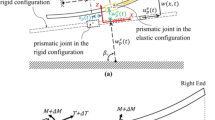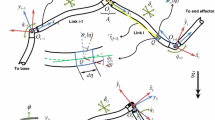Abstract
Dynamic model incorporating damping characteristics, namely joint damping and structural damping in flexible links, of the serial robots with rigid and flexible links is presented. A novel procedure, based on the unified approach of theoretical formulation and analysis of experimental data, is proposed for the estimation of damping coefficients. First, the dynamic model of a robotic system with rigid and flexible links is presented. Next, the modifications in the dynamic model due to the considerations of damping characteristics of joints and structural damping characteristics of the flexible links are presented. A systematic methodology based on analysis of data obtained from experiments is presented for estimation and determination of damping coefficients of rigid-flexible links. The determination of joint damping coefficients, is based on the logarithmic decay of the amplitude of the oscillations of robotic links, while the structural damping coefficients are estimated mainly using the modal analysis and the method of evolving spectra. The method of evolving spectra, based on the Fast Fourier Transform of the decay of the amplitude in structural vibrations of the robot links in progressive windows is used to estimate the structural damping ratios while the critical structural coefficients are determined using the modal analysis. The methodology is illustrated through a series of simple experiments on simple robotic systems. The experimental results are then compared with the simulation results incorporating the damping coefficients determined using the proposed procedure. The comparisons leads to the validation of the proposed dynamic modeling technique, modeling of the damping characteristics, and the method proposed for estimation of damping coefficients for rigid-flexible link robotic systems.
Similar content being viewed by others
References
Cyril, X.: Dynamics of flexible link manipulators. Ph.D. dissertation, McGill University, Canada (1988).
De Luca, A., Siciliano, B.: Closed-form dynamic model of planar multilink lightweight robots. IEEE Trans. Systems. Man Cybern 21(4), 826–838 (1991)
Martins, J., Botto, M.A., Da Costa, J.: Modeling of flexible beams for robotic manipulators. Multibody Syst. Dyn. 7, 79–100 (2002)
Mohan, A., Saha, S.K.: A recursive, numerically stable, and efficients simulation algorithm for serial robots with flexible links. Multibody Syst. Dyn. (2008). doi:10.1007/s11044-008-9122-6
Lankarani, H.M., Nikravesh, P.E.: A contact force model with hysteresis damping for impact analysis of multibody systems. ASME J. Mech. Des. 112, 369–376 (1990)
Ambrosio, J.A.C., Rayn, P.: Elastodynamics of multibody systems using generalized inertial coordinates and structural damping. J. Mech. Struct. Mech. 25(2), 201–219 (1997)
Austin, E.M., Inman, D.J.: Errors in damping predictions due to kinematic assumptions for sandwich beams. In: Proc. of Int. Conf. on Structural Dynamics–Recent Advances, pp. 515–526 (2000)
Mingli, B., Zhou, D.H., Schwarz, H.: Identification of generalized friction for experimental planar two-link flexible manipulator using strong tracking filter. IEEE Trans. Robot. Autom. 15(2), 362–369 (1999)
Chapnik, B.V., Heppler, G.R., Aplevich, J.D.: Modeling impact on a one link-flexible robotic arm. IEEE Trans. Robot. Autom. 7(4), 479–488 (1991)
Feliu, V., Garcia, A., Somolinos, J.A.: Gauge-based tip position control of a new three degree of freedom flexible robot. Int. J. Robot. Res. 20(8), 660–675 (2000)
Mavroidis, C., Dubowsky, S., Raju, V.: End-point control of long reach manipulator systems. In: Proc. of IX World congress on Theory of Machines and Mechanisms, Milan, Sept 1–3 (1995)
Stieber, M.E., McKay, M., Vukovich, G., Petriu, E.: Vision based sensing and control for robotics applications. IEEE Trans. Instrum. Meas. 48(4), 807–812 (1999)
De Luca, A., Siciliano, B.: Regulation of flexible arms under gravity. IEEE Trans. Robot. Autom. 9(4), 463–467 (1993)
Bragliato, B., Rey, D., Pastore, J., Barnier, J.: Experimental comparison of nonlinear controllers for flexible joint manipulators. Int. J. Robot. Res. 17(3), 260–281 (1998)
Queiroz, M.S., Donepudi, S., Burg, T., Dawson, D.M.: Adaptive nonlinear boundary control of a flexible link robot arm. IEEE Trans. Robot. Autom. 15(4), 779–787 (1999)
Feliu, J., Feliu, V., Cerrada, C.: Load adaptive control of single-link flexible arms based on a new modeling technique. IEEE Trans. Robot. Autom. 15(5), 793–814 (1999)
Stanway, J., Sharf, I., Damaren, C.: Validation of a dynamics simulation for a structurally flexible manipulator. In: Proc. of IEEE Conf. on Robotics and Automation, Minnesota, pp. 1959–1964 (1996)
Nikravesh, P.E.: Computer-Aided Analysis of Mechanical Systems. Prentice Hall, New Jersey (1988)
Mohan, A.: Dynamic analysis of flexible multibody robotic systems, Ph.D. dissertation, IIT Delhi, Delhi (2006)
Meirovitch, L.: Analytical Methods in Vibrations. Macmillan, New York (1967)
McIntyre, M.E., Woodhouse, J.: On measuring the elastic and damping constant of orthotropic sheet materials. Acta Metal. 36(6), 1137–1416 (1988)
Thompson, W.T.: Theory of Vibration with Applications. Prentice Hall, London (1988)
Andersson, S., Söderberg, A., Stefan, B.: Friction models for sliding dry, boundary and mixed lubricated contacts. Tribol. Int. J 40, 580–587 (2007)
Pazdera, I.: Friction models in servodrives. Available online, http://www.feec.vutbr.cz/EEICT/2007/sbornik/03-doktorske_projekty/04-silnoprouda_elektrotechnika_a_elektroenergetika/14-xpazde05.pdf
Canudas de Wit, C., Olsson, H., Åström, K.J., Lischinsky, P.: A new model for control of systems with friction. IEEE Trans Autom. Control 40(3), 19–25 (1995)
Jonker, J.B., Aarts, R.G.K.M., Waiboer, R.R.: Modelling of joint friction in robotic manipulators with gear transmissions. In: Garcia Orden, J.C., Goicolea, J.M., Cuadrado, J. (eds.) Multibody Dynamics—Computational Methods and Applications. Computational Methods in Applied Sciences, vol. 4, pp. 221–243. Springer, Berlin (2007). 978-1-4020-5683-3
Norito, N., Shigeru, A.: Evaluation of amplitude dependence of internal friction in high-damping metals. Nippon Kinzoku Gakkaishi 65(2), 109–114 (2001)
De Morton, M.E., Lott, S.A., Stainsby, D.F.: Measurement of internal friction by velocity observations of torsional oscillations. J. Sci. Instrum. 40, 441–443 (1963)
Matveev, V.V.: On determining the damping properties of systems with amplitude-dependent resistance. J. Strength Mater. 2(5), 407–413 (1973)
Wang, Y.Z., Ding, X.D., Xiong, X.M., Zhang, J.X.: Comparative analysis of internal friction and natural frequency measured by free decay and forced vibration. Rev. Sci. Instrum. 78 (2007)
Author information
Authors and Affiliations
Corresponding author
Additional information
The work reported in this paper was carried out in the Dept. of Mechanical Engineering, Indian Institute of Technology Delhi, New Delhi 110016, India.
Rights and permissions
About this article
Cite this article
Mohan, A., Singh, S.P. & Saha, S.K. A cohesive modeling technique for theoretical and experimental estimation of damping in serial robots with rigid and flexible links. Multibody Syst Dyn 23, 333–360 (2010). https://doi.org/10.1007/s11044-010-9188-9
Received:
Accepted:
Published:
Issue Date:
DOI: https://doi.org/10.1007/s11044-010-9188-9




